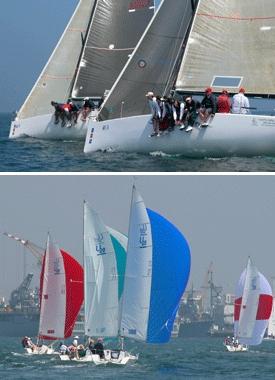As the summer “dinner wind” starts to set in, the evening races can be breezy and puffy. That’s the way it was on the beat back to the “Y” buoy Wednesday night with wind tumbling off the cliffs and accelerating through the gap by the mill. Dealing with the puffs is one thing – some night watch DORADO taking a bight to weather in each puff – knowing what’s ahead and how to describe it is another. Here’s an article from Sailing World on what to look for on the water and how to communicate it to the rest of the crew.
Upwind or down, the key for crews is to feed puff information to the helm. From our June 2003 issue.
On a windy day, especially as you fight your way off the starting line in close quarters, you can hear the calls from the talking heads of your nearest competitors: “Puff in 3 . . . 2 . . . 1 . . . followed by a lull and two steep waves.” Getting this kind of input back to the helmsman is critical, not just at the start, but all around the racecourse, because as you know, huge gains can be made by taking advantage of puffs and lulls, both large and small.
It’s important as a crew to communicate what’s happening with the wind, and do so with confidence. To call a puff effectively, you need to recognize one, determine its size, estimate how strong it is, and figure out what direction it’s moving. But before I go any further, let me stress that it’s just as important to call the lulls preceding or following a puff.
Remember, a puff is simply an increase in breeze—big or small. When I’m calling puffs to the helmsman, I refer to them as fan puffs or directional puffs. A fan puff is the leading edge of a gust, a mass of air dropping from aloft and fanning out from its center of impact as more air piles on top of it. A directional puff is essentially the remnants of the fan puff, overcoming the initial surface contact and moving in the direction of the upper air mass from which it came.
